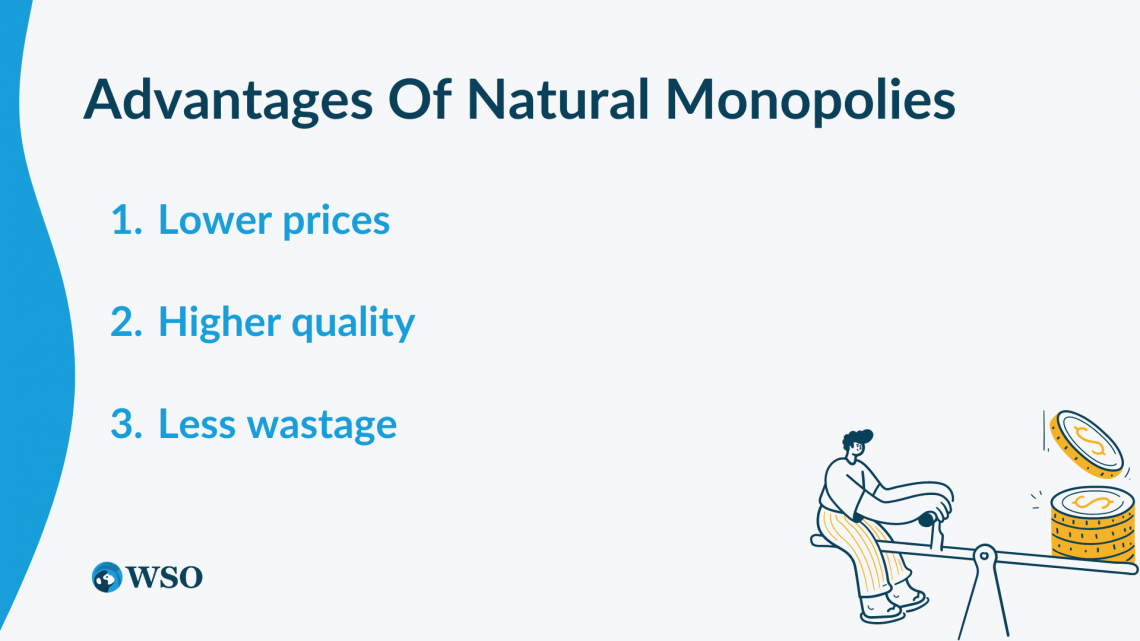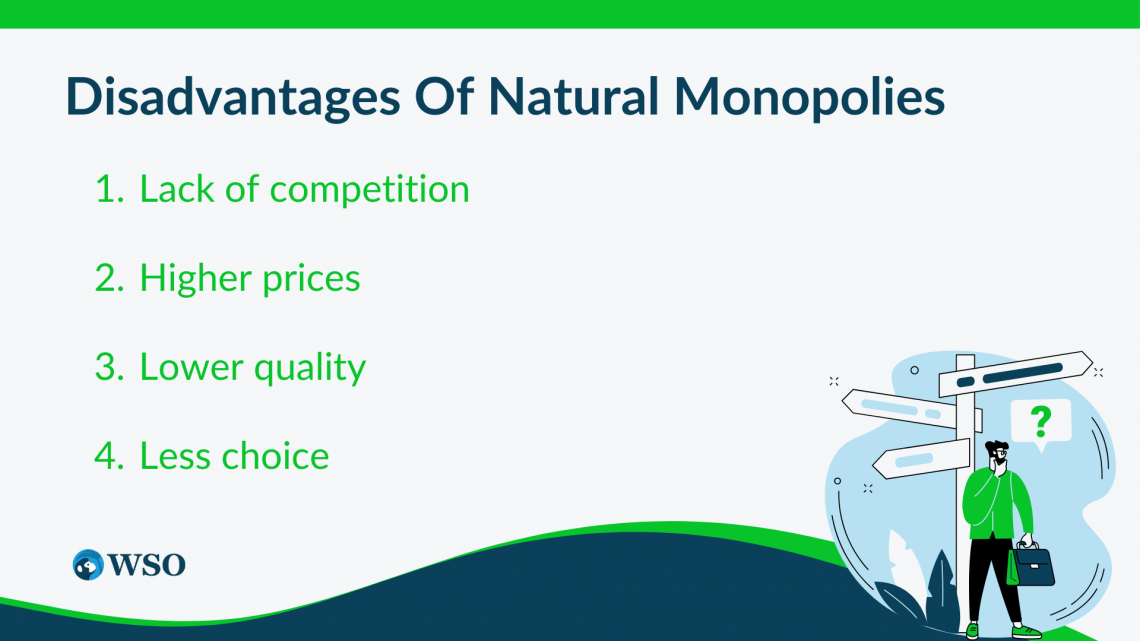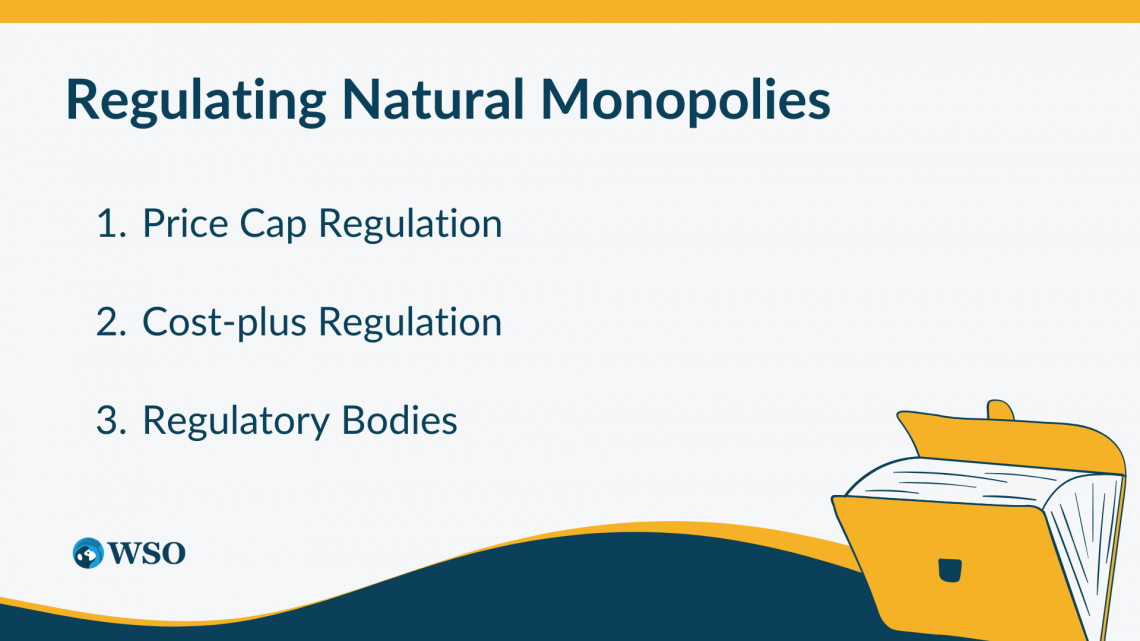Natural Monopoly
It involves a company offering a good or service at a more economical price compared to its competitors.
What is a Natural Monopoly?
A natural monopoly is a type of monopoly that occurs in industries where the infrastructure, technology, or economies of scale make it most efficient for a single company to provide a particular good or service.

Efficiently providing a particular product or service can be done by a single company in a natural monopoly scenario. Competing against the current market leaders would be both financially prohibitive and unfeasible for other businesses.
For example, think about the water supply. To have a solitary organization responsible for both constructing and upkeeping the piping and sewage systems that serve our households is logical. Doing the same thing, picture multiple companies existing simultaneously.
To lay their own pipes, dig up roads, and fork over a large sum of money is inevitable and will cause major disruption. Any potential cost savings would be negated by the fact that we would still be charged for utilizing the water.
In essence, our financial situation would remain unchanged. In fact, we might end up paying more because each company would have higher costs than if there was only one.
So, a natural monopoly is when having one company is better than having many, both for the company and for the consumers. There are no alternative options; therefore, the company substantially influences the market.

We can't switch to another provider if they decide to raise their prices or lower their quality. The government often regulates natural monopolies by imposing rules and limitations on their pricing and quality standards.
This approach is necessary because natural monopolies can abuse their market power and exploit consumers. Consumers and companies are both subject to the government's need for equilibrium. They do this so that we get a fair deal and the company still makes a profit.
Some other examples of natural monopolies are natural gas distribution, postal services, and telecommunications infrastructure. These industries require a lot of infrastructure and investment, and having multiple providers would be inefficient and wasteful.
Generally speaking, natural monopolies maintain their position for a long time, though there may be exceptions or technological advancements that allow newcomers to compete.
Key Takeaways
- The market structure known as natural monopoly involves a company offering a good or service at a more economical price compared to its competitors.
- Natural monopolies often arise when there are high fixed costs or economies of scale. It can also occur when there is a limited resource that only one firm can access or control.
- Natural monopolies tend to charge higher prices and produce lower quantities than competitive markets. This can result in allocative inefficiency and deadweight loss for society.
- Natural monopolies may also have less innovation and quality improvement than competitive markets. This is because they have no pressure to improve their products or services since they have a captive market.
- They may also have more market power and influence over regulators and policymakers than competitive firms.
- The government often regulates natural monopolies. This prevents them from abusing their market power and exploiting consumers.
Characteristics Of Natural Monopolies
These types of corporations exist in a type of market where only one firm can provide a good or service efficiently and at a lower cost than any potential competitor. New entrants often struggle to compete due to the presence of high fixed costs or economies of scale.

Electricity, phone services, and water are a few instances of natural monopolies, such as public utilities. How do natural monopolies set their prices? If they are unregulated, they will charge the highest price that the market demand allows them to.
They will produce at the quantity where their marginal revenue (the extra revenue from selling one more unit) equals their marginal cost (the extra cost of producing one more unit). This way, they maximize their profits.
However, this also means they will produce less than the socially optimal quantity and charge more than the socially optimal price. This creates a deadweight loss, which is a loss of economic efficiency and welfare.

How can we regulate natural monopolies? Average cost pricing, out of many ways, is a popular approach. This rule requires the natural monopoly to charge a price that is equal to its average cost (the total cost divided by the total output) of production.
This way, the natural monopoly can cover its costs and earn a normal profit, not excessive.
The average cost pricing rule also reduces the deadweight loss and increases the consumer surplus (the difference between what consumers are willing to pay and what they actually pay). However, the average cost pricing rule is not perfect.
It still results in a lower quantity and a higher price than the efficient level, where the price equals the marginal cost. Since the natural monopoly can pass on the added expenses to consumers, it might be motivated to inflate costs or reduce efficiency.
Advantages And Disadvantages Of Natural Monopolies
Due to natural monopoly, only one company can efficiently offer a specific product or service in the market. This is because it has superior cost-effectiveness compared to any other contender.

This happens when the industry has very high fixed costs, which are the costs that don't change no matter how much you produce. So, it makes sense to have only one company doing it rather than having many companies competing and duplicating the infrastructure.
However, alternative approaches to introducing competition in these markets include infrastructure sharing and implementing market-based mechanisms. In this type of monopoly, what are its advantages and disadvantages?
The advantages of a Natural Monopoly are as follows:
1. Lower prices
A natural monopoly can charge lower prices than multiple firms because it can spread its fixed costs over many customers and benefit from economies of scale. This means that the average cost of production decreases as the output increases.
Less money per water unit is charged by a water company that serves numerous customers, say 10 million, compared to one that serves just a million.
2. Higher quality
This type of monopoly can also provide higher quality products or services than multiple firms because it can invest more in research and development, innovation, and maintenance.
Example
A cable company can offer faster internet speeds and more channels than several smaller companies with limited resources and capabilities.
3. Less wastage
A natural monopoly can also reduce wastage and pollution by avoiding duplication of infrastructure and equipment. For example, having one electricity grid instead of many can save energy and prevent blackouts.
Some of the disadvantages of Natural Monopoly are:

1. Lack of competition
A natural monopoly can also have some drawbacks, mainly due to the lack of competition in the market. This can lead to:
2. Higher prices
This type of monopoly can abuse its market power and charge higher prices than the socially optimal level, which is the price that maximizes the welfare of both producers and consumers.
This can result in allocative inefficiency, which means that resources are not used best.
Note
Too pricey electricity rates could result in reduced power usage or an inability to financially keep up with the company's service fees from certain consumers.
3. Lower quality
A natural monopoly can also lower the quality of its products or services because it has no incentive to improve or innovate. In a scenario where resources aren't utilized cost-effectively, one can encounter productive inefficiency.
For example, if a water company does not maintain its pipes properly, it may cause leaks or contamination.
4. Less choice
A natural monopoly can also limit the choice of consumers by offering only one product or service or by restricting access to other providers.
Certain channels or programs may become exclusive to a cable company and subsequently prevent customers from accessing their preferred content.
Regulating Natural Monopolies
The problem is that these companies have no incentive to operate efficiently or charge fair prices. Since they face no competition, they can charge whatever they want and make huge profits by exploiting their market power.

Lower quality services and higher prices result from this, ultimately harming the consumer. It is also bad for society because it creates a deadweight loss of economic surplus.
Regulating prices and operations is a method to control the power of natural monopolies. There are different regulation methods; there are two main ones: price cap regulation and cost-plus regulation.
1. Price Cap Regulation
When the government sets a maximum price, the natural monopoly can charge for its service. This price is usually based on some measure of inflation and efficiency improvements.
Note
To incentivize the monopoly, the goal is to decrease costs and boost productivity concurrently with maintaining affordable customer pricing. This ensures that monopoly-produced goods and services are affordable to the average consumer.
2. Cost-plus Regulation
Cost-plus regulation is when the government allows the natural monopoly to charge a price that covers its average cost of production plus a reasonable rate of return. This price is usually based on the monopoly's reported costs and is audited by the government.
The idea is to ensure that the monopoly can cover its expenses and earn a fair profit while preventing excessive pricing.
3. Regulatory Bodies
In some cases, it is best to allow the natural monopoly to exist. For example, creating multiple postage companies would be hugely inefficient because it would be cheaper to operate one company that serves the entire country.
In the United States, the United States Postal Service is a natural monopoly that the government regulates.
Note
The government ensures that the monopoly's pricing is fair and affordable while maintaining the efficiency benefits of this market structure.
Which method is better? In each method, pros and cons exist. Price cap regulation can encourage innovation and efficiency but can also lead to underinvestment and quality deterioration.
Cost-plus regulation can ensure adequate investment and quality but can also create moral hazard and cost inflation. Each industry and market presents unique characteristics, so it's hard to say which method is the most effective.
As a result, it is best to consider the broader situation. Both types of regulations have their strengths and weaknesses, which affect which situations they are best suited for.
Natural Monopoly Example
This market structure could form due to factors like economies of scale, network effects, or ownership of a scarce resource. Let's consider some examples.

Economies of scale mean that the more you produce, the lower your average cost becomes. This happens when you have high fixed costs and low variable costs. Economies of scale form when the average cost of production decreases as output increases.
This can be due to spreading fixed costs over larger goods or services. For example, think of a water company.
It has to invest a lot of money in building pipes and infrastructure to deliver water to customers. But once it does that, the cost of providing an extra water unit is very low. So, the more customers it has, the lower its average cost becomes.
This makes it hard for new entrants to compete with the existing water company because they would have to incur the same high fixed costs but with fewer customers. Therefore, the water company can enjoy a natural monopoly in its area.
As more people use a product or service, its value increases through network effects. This happens when positive externalities or spillovers from using the same product or service exist. Consider Facebook, for example.
For each user, Facebook's value increases with more people joining the platform, granting access to more family and friends, events, groups, and information.

It becomes difficult for new competitors to challenge Facebook because the existing user network creates a favorable cycle of attracting more users. Therefore, Facebook can enjoy a natural monopoly in its market.
However, natural monopolies can limit innovation. In more competitive markets, a large group of suppliers ensures diversity in product and service types.
In monopoly market structures, high entry barriers reduce competition and the variety of products offered to consumers. As a result, many alternatives to natural monopolies try to incorporate more competition to promote innovative products and solutions.
Ownership of a scarce resource means that one company has exclusive access to a vital input that is necessary for producing a product or service. This happens when legal barriers or physical limitations prevent others from obtaining the same input.
Natural Monopolies Created by Law
Think of a diamond company like De Beers. Certain countries and regions have granted it exclusive diamond mining rights. This gives it a near monopoly on the worldwide supply and distribution of diamonds.

This makes it hard for new entrants to compete with De Beers because they would have to find alternative sources of diamonds that are either more expensive or less quality. Therefore, De Beers can enjoy a natural monopoly in its industry.
Natural monopolies form when one company has a huge advantage over its competitors due to factors like economies of scale, network effects, or ownership of a scarce resource.
These factors create barriers to entry that prevent other companies from entering the market and competing effectively.
Note
Natural monopolies have an advantage over their competitors.
This creates significant barriers to entry that prevent other firms from effectively competing in the market. These barriers can include high initial investment costs, regulatory barriers, or control over limited resources.
This enables them to boost their prices to higher levels than those found in a competitive market. Consequently, they can enjoy higher profits.
However, natural monopolies can also face some challenges and risks, such as regulation, innovation, and consumer backlash.




or Want to Sign up with your social account?